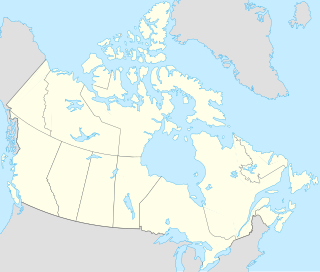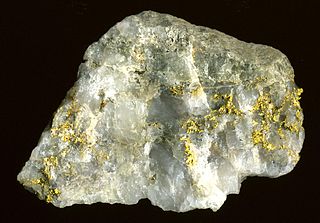
An ore is an occurrence of rock or sediment that contains sufficient minerals with economically important elements, typically metals, that can be economically extracted from the deposit. The ores are extracted from the earth through mining; they are then refined to extract the valuable element, or elements.

The Pine Point Mine is located on the south shore of Great Slave Lake between Hay River to the east and Fort Resolution to the west, in the Northwest Territories of Canada. It produced lead and zinc ores from a Mississippi Valley Type deposit between 1964 and 1988. Most of the mining was done by open-pit methods. The town of Pine Point was built by the mining company, Cominco, and when the mine closed the town was abandoned and demolished.

Various theories of ore genesis explain how the various types of mineral deposits form within the Earth's crust. Ore-genesis theories vary depending on the mineral or commodity examined.
Hudbay Minerals Inc. is a Canadian mining corporation. Tracing its history to the Hudson Bay Mining and Smelting Co., Limited (HBMS), the company has been exploring and mining in Manitoba for over 80 years. Much of its history has centered on Flin Flon, Manitoba. HudBay now has operations in Manitoba, Peru, and Yukon.

Uranium mining in Colorado, United States, goes back to 1872, when pitchblende ore was taken from gold mines near Central City, Colorado. The Colorado uranium industry has seen booms and busts, but continues to this day. Not counting byproduct uranium from phosphate, Colorado is considered to have the third largest uranium reserves of any US state, behind Wyoming and New Mexico.

In-situ leaching (ISL), also called in-situ recovery (ISR) or solution mining, is a mining process used to recover minerals such as copper and uranium through boreholes drilled into a deposit, in situ. In situ leach works by artificially dissolving minerals occurring naturally in a solid state. For recovery of material occurring naturally in solution, see: Brine mining.

Romania ranks tenth in the world in terms of the diversity of minerals produced in the country. Around 60 different minerals are currently produced in Romania. The richest mineral deposits in the country are halite.
Hydrocarbons are the leading sector in Algeria’s mineral industry, which includes diverse but modest production of metals and industrial minerals. In 2006, helium production in Algeria accounted for about 13% of total world output. Hydrocarbons produced in Algeria accounted for about 2.9% of total world natural gas output and about 2.2% of total world crude oil output in 2006. Algeria held about 21% of total world identified resources of helium, 2.5% of total world natural gas reserves, and about 1% of total world crude oil reserves.
The mineral industry of Kazakhstan is one of the most competitive and fastest growing sectors of the country. Kazakhstan ranks second to Russia among the countries of the CIS in its quantity of mineral production. It is endowed with large reserves of a wide range of metallic ores, industrial minerals, and fuels, and its metallurgical sector is a major producer of a large number of metals from domestic and imported raw materials. In 2005, its metal mining sector produced bauxite, chromite, copper, iron, lead, manganese, and zinc ores, and its metallurgical sector produced such metals as beryllium, bismuth, cadmium, copper, ferroalloys, lead, magnesium, rhenium, steel, titanium, and zinc. The country produced significant amounts of other nonferrous and industrial mineral products, such as alumina, arsenic, barite, gold, molybdenum, phosphate rock, and tungsten. The country was a large producer of mineral fuels, including coal, natural gas, oil, and uranium. The country's economy is heavily dependent on the production of minerals. Output from Kazakhstan's mineral and natural resources sector for 2004 accounted for 74.1% of the value of industrial production, of which 43.1% came from the oil and gas condensate extraction. In 2004, the mineral extraction sector accounted for 32% of the GDP, employed 191,000 employees, and accounted for 33.1% of capital investment and 64.5% of direct foreign investment, of which 63.5% was in the oil sector. Kazakhstan's mining industry is estimated at US$29.5 billion by 2017.
The mineral industry of Africa is the largest mineral industries in the world. Africa is the second largest continent, with 30 million km² of land, which implies large quantities of resources. For many African countries, mineral exploration and production constitute significant parts of their economies and remain keys to economic growth. Africa is richly endowed with mineral reserves and ranks first or second in quantity of world reserves of bauxite, cobalt, industrial diamond, phosphate rock, platinum-group metals (PGM), vermiculite, and zirconium. Gold mining is Africa's main mining resource.
Mining is the biggest contributor to Namibia's economy in terms of revenue. It accounts for 25% of the country's income. Its contribution to the gross domestic product is also very important and makes it one of the largest economic sectors of the country. The majority of revenue comes from diamond mining.
Star Uranium is a Canadian resource company with its head office in Saskatoon, Saskatchewan. The company is focused on the acquisition, exploration and development of uranium, diamond and other precious metal properties.
United Uranium is a Canadian resource company with its head office in Saskatoon, Saskatchewan. The company is focused on the acquisition, exploration and development of natural resources such as uranium, diamond, copper and other precious metals.
Bard Ventures Ltd. is a Canadian-based mining company and is listed on the TSX Venture Exchange. It has mineral properties in British Columbia and is headquartered in Vancouver. The main focus is on molybdenum.

The Artillery Mountains are a mountain range in Mohave County in western Arizona. High point of the range is Artillery Peak, 2,917 feet above sea level. Artillery Peak is at coordinates N 34.36946 W 113.58160.
Adex Mining Inc. is a Toronto, Ontario, Canada-based mining exploration company engaged in the development of its wholly owned Mount Pleasant Mine property in Charlotte County, New Brunswick, Canada. According to a Government of Canada report, Mount Pleasant is "North America's largest tin deposit and the world's largest reserve of indium." The company's stock trades on the TSX Venture Exchange under the symbol ADE.
Mauritania's mineral sector was dominated by iron ore mining and beneficiation. Other mineral commodities produced in the country included cement, copper, gold, gypsum, petroleum, salt, and steel. The Ministère des Mines et de l’Industrie was the Government agency responsible for enacting the Mining Code and for the coordination of all activities in the mining sector. The Direction des Mines et de la Géologie was the entity responsible for promoting the mineral sector and for providing geologic and mining information to potential investors; the Direction des Hydrocarbures was in charge of the development of the petroleum sector; and the Office Mauritanien des Recherches Géologiques was the Government entity responsible for evaluating areas of mineral potential for exploration. Société Nationale Industrielle et Minière (SNIM) was responsible for iron ore production and benefciation.

Hathor Exploration Limited is a uranium exploration company based in Vancouver, British Columbia, Canada. Its exploration office is located in Saskatoon, Saskatchewan, Canada. Hathor's exploration projects concentrate on properties within the Athabasca Basin of Northern Saskatchewan, Canada.

Orex Exploration is a Canadian advanced stage junior gold exploration company headquartered in Montreal, Quebec. It operates in Nova Scotia, Canada with a focus on exploring former gold mines and properties in the Goldboro, Nova Scotia, and surrounding areas of Guysborough County, Nova Scotia.
Svenska Bergsbruk, formerly Wiking Mineral, is a junior mineral exploration and mine development company. The firm was founded in 2005, and primarily engages in mine development and active exploration for base and precious metal deposits in Sweden.














